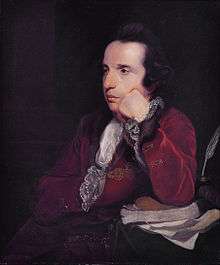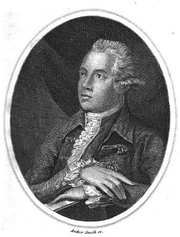George Colman the Elder
George Colman (April 1732 – 14 August 1794) was an English dramatist and essayist, usually called "the Elder", and sometimes "George the First", to distinguish him from his son, George Colman the Younger. He was also a theatre owner.

Early life
He was born in Florence, where his father was stationed as British Resident Minister (diplomatic envoy) at the court of the Grand duke of Tuscany. Colman's father died within a year of his son's birth, and the boy's education was undertaken by William Pulteney, afterwards Lord Bath, whose wife was Mrs Colman's sister. After attending a private school in Marylebone, George was sent to Westminster School.
Colman left school in due course for Christ Church, Oxford. There he made the acquaintance of Bonnell Thornton, the parodist, and together they founded The Connoisseur (1754–1756), a periodical which although it reached its 140th number, "wanted weight," as Johnson said. He left Oxford after taking his degree in 1755, and having been entered at Lincoln's Inn before his return to London, he was called to the bar in 1757. A friendship formed with David Garrick did not help his career as a barrister, but he continued to practise until the death of Lord Bath, out of respect for his wishes.


Plays
In 1760, Colman produced his first play, Polly Honeycomb, which met with great success. In 1761, The Jealous Wife, a comedy partly founded on Tom Jones, made Colman famous. The death of Lord Bath in 1764 placed him in possession of independent means. In 1765, his metrical translation of the plays of Terence appeared, and in 1766, he produced The Clandestine Marriage, jointly with Garrick, whose refusal to take the part of Lord Ogleby led to a quarrel between the two authors. In the next year he purchased a fourth share in the Covent Garden Theatre, a step which is said to have induced General Pulteney to revoke a will by which he had left Colman large estates. The general, who died in that year, did, however, leave him a considerable annuity. There was a riot at the third performance of his play The Oxonian in Town on 9 November 1767, apparently sparked by a claque of card-sharpers.[1]
Theatre ownership
Colman was acting manager of Covent Garden for seven years, and during that period he produced several "adapted" plays of Shakespeare. He directed Mary Bulkley, Ann Catley and others in the première of She Stoops to Conquer there in 1773.[2] In 1768 he was elected to the Literary Club, then nominally consisting of twelve members. In 1771 Thomas Arne's masque The Fairy Prince premièred at Covent Garden, for which Colman wrote the libretto. In 1774 he sold to James Leake his share in the playhouse, which had involved him in much litigation with his partners, and three years later purchased the little theatre in the Haymarket from Samuel Foote, then broken in health and spirits. Colman was attacked by paralysis in 1785; in 1789 his brain became affected, and he died on 14 August 1794. He was buried in Kensington Church.[3]
Other works
Besides the works already cited, Colman was author of adaptations of Beaumont and Fletcher's Bonduca, Ben Jonson's Epicoene and Volpone, Milton's Comus, and of other plays. He also produced an edition of the works of Beaumont and Fletcher (1778), a version of the Ars Poëtica of Horace, an excellent translation from the Mercator of Plautus for Bonnell Thornton's edition (1769–1772), some thirty plays, and many parodies and occasional pieces. An incomplete edition of his dramatic works was published in 1777 in four volumes.[4]
Selected plays
- Polly Honeycombe (1760)
- The Jealous Wife (1761)
- The Clandestine Marriage (1766)
- The Oxonian in Town (1767)
- The Manager in Distress (1780)
- The Genius of Nonsense (1780)
References
- The Diary of Sylas Neville 1767–1788, ed. Basil Cozens-Hardy. (London, OUP, 1950), p. 27.
- Illustrated London News, Saturday 31 October 1896 p8 col2-3: Chapter XII
- Dictionary of National Biography
- Olive Baldwin and Thelma Wilson, "Colman, George, the elder (baptised 1732, d. 1794)", Oxford Dictionary of National Biography (Oxford, UK: OUP, 2004) Retrieved 29 January 2017, pay-walled.
- Colman, George, New Brooms!, London, 1776. Facsimile ed., with The Manager in Distress (1780), introduced by J. Terry Frazier, 1980, Scholars' Facsimiles & Reprints, ISBN 978-0-8201-1353-1.

External links
- George Colman at James Boswell – a Guide
- Portraits from the National Portrait Gallery
- Works by George Colman at Project Gutenberg
- Works by or about George Colman the Elder at Internet Archive